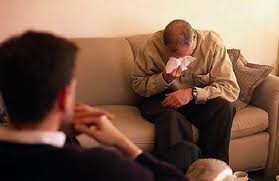
 This is a question that many patients ask me on entry into care. They are sad, dispondent and usually a tad bit frustrated. There is no simple quick answer or solution to this serious medical illness. However, as a practitioner, we have to help our patients come-up with the possible theories and integrated solutions for their distress.
This is a question that many patients ask me on entry into care. They are sad, dispondent and usually a tad bit frustrated. There is no simple quick answer or solution to this serious medical illness. However, as a practitioner, we have to help our patients come-up with the possible theories and integrated solutions for their distress.
I basically take a five-step approach with most of my therapy patients:
1. Make sure their are no safety issues. I query all my patients for both suicidal and homicidal ideation in the initial examination. This is very important. Danger to self and or danger to others has to be evaluated at the beginning of interactions with new patients. If the queries are both negative, then proceed to step #2. However if either query is positive, inpatient hospitalization is the ONLY answer.
2. If all things are clear, you can then proceed to this step. Next you must ESTABLISH RAPPORT! This has to be done at the outset. If you and the patient don’t connect in Psychiatry that could certainly be a problem. Both the patient and the therapist/doctor have to feel free to communicate and ask questions of each other. This is cardinal in the actual process of therapy. Good Luck!
3. Put the patient “AT EASE.” A patient has to be comfortable with you. A lot of anxiety may cause the patient to either “choke-up” or “shut-down.” Catharsis or release will be very important in each session. In the therapy hour, there should be an expected outcome or goal. Some sessions may derail because of the patient’s own personal crisis, but each section should overall be moving towards wellness.
4. Allow the patient to process by utilizing “Empathetic Listening.” This is so very important. For the most part, I try not to do therapy on very-very busy days. If too busy, I might present a little distracted and unable to really focus on what the needs of an individual patient is at that particular time. We as clinicians have to be careful that we don’t bring or own garbage into therapy sessions.
5. Make some “soft clinical recommendations” after each session. It may be medication management, breathing exercises, or other relaxation therapy techniques. This is very important. You have to be vested in each patient’s care. I do not use such words as “consumer” and or “client” because they seem to break the therapeutic process. True therapy has to have the essential components that are listed in this post.
6. Agree on a TREATMENT PLAN. The treatment plan should be cohesive and coherent for both the patient and the therapist. The therapist should be able to make all of the agreed upon appointments at the agreed upon time. The patient should also be able to make the appointments at the agreed upon time. The patient should also be prepared to pay the fee associated with each visit before the start of the session.
I hope this post has been helpful for the new clinician, but before I go let’s take a quick quiz;
1. Should a patient pay before or after each session?
2. Is it appropriate to take notes during therapy sessions?
3. Is it alright for a patient to bring family members into a therapy session?
4. Should you give medications to a patient that you are also providing therapy for?
5. If marriage counseling is appropriate, should each partner be evaluated separately by a different clinician before starting marital therapy?
Answer Key:
1. A patient should pay at the beginning of each session. If there is no value on the session, they may become uninvested in the process. (co-pay or fee for service)
2. There is nothing wrong with taking minimal notes during the session. However, never loose eye-contact with the patient during the hour.
3. If a patient wishes to bring a family member or friend to a session, by all means, allow them to do just this. This shows better investment in the process of therapy and make help you to see the patient through the eyes of others at home.
4. If you are the doctor, refer the patient out for therapy if you are providing medication management. Sometimes discussing medications and its side-effects can take up your time in actual process therapy.
5. In my opinion, each partner should have their own diagnostic completed by a separate clinician before starting marital therapy with you. You need to be sure that there are no psychiatric co-morbidities (psychosis, depression, suicidality, and others) existent before the process of therapy starts.
Thanks for listening,
Dr.Owens
I am available for supervision if needed. (LPCs, LAPCs, LMSWs, LCSW, ect.) Call my office at 404-575-4785 to discuss possible arrangements.
Don’t forget to pick-up my book, “Am I In a Bad Relationship” on Amazon.Com.



